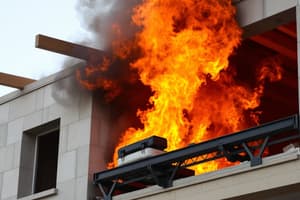Podcast
Questions and Answers
Which of the following are factors that influence fire behavior? (Select all that apply)
Which of the following are factors that influence fire behavior? (Select all that apply)
- Basic building classification (correct)
- Occupancy classification (correct)
- Fire resistance (correct)
- Fire or fuel load (correct)
What do building codes initially classify structures by?
What do building codes initially classify structures by?
Materials used in construction
What are common building classifications? (Select all that apply)
What are common building classifications? (Select all that apply)
- Type 6 - Reinforced concrete
- Type 1 - Fire resistive (correct)
- Type 3 - Exterior protected (masonry) (correct)
- Type 2 - Noncombustible or protected noncombustible (correct)
What do building classifications indicate?
What do building classifications indicate?
Building codes use only the ________ to indicate a building's classification.
Building codes use only the ________ to indicate a building's classification.
With the exception of type IV, heavy timber, how are major classifications further divided?
With the exception of type IV, heavy timber, how are major classifications further divided?
What is NFPA 220?
What is NFPA 220?
What does Type I - fire resistive construction include?
What does Type I - fire resistive construction include?
Glass and aluminum can be used in Type I construction.
Glass and aluminum can be used in Type I construction.
When can building codes omit the fire resistive rating for a roof construction?
When can building codes omit the fire resistive rating for a roof construction?
What is Type II-A classification?
What is Type II-A classification?
What is Type II-B classification?
What is Type II-B classification?
What is the most common masonry in Type III construction?
What is the most common masonry in Type III construction?
What typically distinguishes Type IV - heavy timber construction?
What typically distinguishes Type IV - heavy timber construction?
What major component can be combustible in Type V construction?
What major component can be combustible in Type V construction?
Flashcards are hidden until you start studying
Study Notes
Factors Influencing Fire Behavior
- Basic building classifications: crucial in determining how a structure behaves during a fire.
- Occupancy classification affects the fire risk and safety measures required.
- Fire or fuel load refers to the amount and nature of combustible materials in a building.
- Fire resistance indicates how well a building can withstand fire exposure.
Building Codes and Classification
- Structures are initially classified based on the materials used in their construction.
- Building classifications indicate the likelihood of structural collapse during fire and the safety of occupants.
- Numerical designation is the only means used by building codes to indicate a building's classification.
Common Building Classifications
- Type I: Fire resistive, featuring noncombustible components, with fire resistance ratings of 2-4 hours for bearing walls and 1-2 hours for roof decks.
- Type II: Noncombustible or protected noncombustible, where Type II-A requires components to have 1-hour fire resistance and Type II-B can have unprotected components.
- Type III: Exterior protected, often with masonry or equivalent materials; has Type III-A (protected) and Type III-B (unprotected) subclasses.
- Type IV: Heavy timber construction, with solid or laminated wood structural elements and no concealed spaces. Designation 2HH indicates heavy timber dimensions.
- Type V: Wood frame construction, allowing for combustible materials in structural components, often requiring a fire resistance rating.
NFPA 220 Standard
- Establishes types of building construction with classifications represented by a 3-digit number that indicates fire resistance ratings for walls, frames, and floors.
Specifics on Type I Construction
- Commonly uses protected steel frames or reinforced concrete components, with insulation for steel to enhance fire resistance.
- Local codes apply to interior partitions and occupancies.
Type II Construction Characteristics
- Type II-A allows for protected noncombustible components with 1-hour fire ratings.
- Type II-B consists of unprotected noncombustible components, commonly resulting in faster failure during fires depending on factors like ceiling height and steel member size.
Type III Construction Details
- Combines masonry with ordinary framing, using concealed spaces that must have fire stops to prevent fire spread.
- Common features include 2x10" joists and potential combustible concealed spaces post-renovation.
Type IV and V Construction
- Type IV is recognized for its heavier structural wood components and lack of concealed spaces, posing unique fire hazards due to fuel present in supports.
- Type V allows all structural components to be combustible with extensive voids, alongside specific height and area limitations imposed by building codes.
Studying That Suits You
Use AI to generate personalized quizzes and flashcards to suit your learning preferences.




